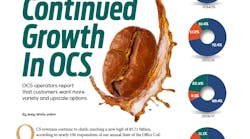We asked industry leaders and members of the Automatic Merchandiser Editorial Advisory Board to weigh in on which trends impacted micro markets in 2019 and what operators need to know in order to prepare for another year of success. Here are their remarks on micro markets across the industry.
Customer loyalty programs benefit operators, suppliers
A recent Oracle study found that 72 percent of adults utilize at least one loyalty program and two-thirds of these programs are associated with high-frequency businesses. Operators can capitalize upon the popularity of loyalty programs by offering them at micro market locations, rewarding customers who shop there regularly.
“Anything that affects consumer engagement, mobile engagement, loyalty and data-driven promotions is driving this [trend],” said Joe Hessling, founder and CEO of 365 Retail Markets.
Hessling noted that 365 recently launched its 365Pay app, giving consumers a more streamlined shopping experience. He said that communicating with operators, managing loyalty, receiving promotions, making purchases and reviewing past purchases has never been easier for the end user. The app also helps operators run their business more efficiently, quickly attending to customers’ needs.
“The requests for features related to efficiency and consumer engagement are a daily occurrence,” Hessling said. “Operators are embracing the changes and running with them for longer contracts and better sales.”
Malcolm McAlpine, business manager, branded snacks and confections at Mondelēz International, said that Mondelēz sees value in marketing, promotions and loyalty programs for micro markets.
“This year and continuing into next year, we are focusing a lot more sales and marketing efforts on micro markets to keep up with the trends and the growth of the segment,” he said. “We will also promote aggressively to the micro market consumer, with bundling and loyalty programs.”
Smaller locations have big potential
While micro markets were initially envisioned for larger office environments, compact point-of-sale systems and space-saving design solutions have allowed operators to expand into smaller locations, which can be surprisingly profitable.
“When we first started, we felt that the micro market ‘sweet spot’ had a certain threshold for sales and populations and locations,” explained Jim Brinton, CEO at Avanti Markets. “And now, operators are having to take a hard look and say, ‘Maybe those smaller locations actually make financial sense as well.’”
Hessling added that 365 recognized the demand for smaller point-of-sale systems, tablets and mobile-based options through the 2017 launch of their nanomarket™ kiosk and their forthcoming PicoMarket.
“Our nanomarket™ has gone from launching in 2017 to our second bestselling product in 2019,” he said. “We have been working diligently on the PicoMarket, which is the perfect fit for operators that want to be on one back-end system throughout all of their locations, big or small. The PicoMarket can be utilized as a standalone pointof-sale in a connected campus setting or simply placed on individual vending machines or coolers.”
Michael Kasavana, NAMA endowed professor emeritus and hospitality business consultant, concurred that the nanomarket™ helped operators effectively monitor and control “marketplaces geared to smaller populations.” He added that enabling consumers to scan and purchase items through a virtual shopping cart with their smartphones is not only ideal for smaller locations, but also provides a convenient “uninterrupted departure” for end users.
Steve Orlando, co-founder and chief business development officer at Fixturelite, advised that just because a location is small doesn’t mean that operators should forego retail design elements in these previously overlooked spaces.
“It’s as important to invest in the small spaces as it is the larger spaces, and that is why we designed solutions for spaces large and small,” Orlando said. “Increased sales revenue correlates to the experience an operator creates in the retail space and that doesn’t typically change simply because the audience is smaller. We’ve seen where operators look at a small space with less than 100 people and say, ‘I’m not going to invest in that because it’s only 100 people.’ But if they design a destination that draws shoppers in — while using technology that makes sense — they might see that untapped location generates revenue equivalent to a 200-person location.”
Consumers want variety
In addition to carrying the traditional food and beverage items consumers know and love, operators need to expand offerings with better-for-you products, fresh food and a larger selection of snack and meal options.
“Another trend in micro markets is the diversity of what’s being offered, whether that’s different variations and types of product, new and more flavors, or multiple packages and sizes,” McAlpine said. “It’s all about options and providing an assortment that consumers can choose from. While consumers do still enjoy that traditional sweet or salty snack, they are more health-conscious and also want snack options that they see as better-for-you.”
McAlpine said that Mondelēz Foodservice has responded to this trend by making a large assortment of snacking options available to operators to meet their consumers’ demands. Mondelēz also assists operators by identifying snacking trends and habits that impact their target markets.
“We ensure that we’re making operators aware of trends as well as the different snacking habits and preferences of the different demographic cohorts so that they can source and slot the appropriate products,” he said, adding that manufacturer competition for slots in micro markets has also become more intense.
"Because it’s such an attractive segment, this competition will continue to grow at the same rate micro markets are,” he said.
Josh Rosenberg, advisor, Accent Food Services and CEO of PLNTSOP, said that product diversification is the No. 1 trend impacting micro markets.
“In order to get our share of the consumers’ wallet, we have to deliver what they want, when they want it, how they want it,” he said. “And that diversification of product has put pressure on the traditional supply chain and the big box suppliers that dominate our space. As we bring these new products to market — whether it’s fresh food, perishable cold brews, kombucha or perishable proteins — inventory, warehouse and trucking have become far more complex and expensive. You have to recapitalize your fleet in order to be able to support it.”
Managing inventory has grown more complex as micro market clients demand a wider variety of products. Offering a wider variety of products is only possible — and profitable — if the operator is equipped to effectively manage an increased number of SKUs.
“Operators are being held more responsible for professional product management,” Hessling added. “Having product available is not enough anymore — effectively managing it is the client expectation.”
Integrating systems improves management
When vending operators started expanding into micro markets, they quickly realized the need to integrate their systems to ensure efficiency and manage inventory.
“I started in the micro market space back in 2010 and I have watched operators be hesitant to the concept, then buy into the concept and then want to make micro markets a part of their growth strategy in their business,” said Elyssa Steiner, director of marketing at USA Technologies. “In recent years, with growth has come new challenges for operators when their multiple technology platforms don’t transfer data from system to system.”
Steiner said that she’s seen a shift, especially over the past year, where operators aren’t talking about if they should integrate their market and vending systems, but rather how quickly they can do it, especially if they’re interested in scaling their business.
“I think it is making operators more efficient and provides peace of mind and control of their operations,” she said. “And, ultimately, it allows them to track profitability across all lines of their business in one place while streamlining processes for their people.”
In order to help operators achieve growth and overall success, USA Technologies developed a solution that integrates with most micro market providers.
“We learned quickly that we needed to integrate with all or as many major micro market providers as possible to support the business of the operator,” she said. “We worked to achieve that throughout the early part of 2019 and continue to look at ways to optimize the workflows to help operators leverage the Seed platform for a central management platform.”
While operators certainly benefit from a streamlined operation, the true benefit is passed on to the end user.
“I think that the operator is truly able to provide a better customer experience ensuring the right product is there at the right time when the consumer wants it,” Steiner added.
Micro markets design takes it up a notch
Continued low unemployment and a strong U.S. economy mean that employers are willing to go the extra mile to retain valuable workers. By creating inviting spaces for their employees to enjoy their snacks or meals, employers can increase the amount of time their workforce spends in the office. Orlando said his clients are interested in creating an elevated experience for their employees.
Orlando said he often asks operators, “‘If retail, coffee, and food establishments hire designers to create an experience for their customers around their brand that results in customer and brand loyalty, why would your micro market business be an exception?’ The response is almost always, ‘I see your point; I hadn’t thought about it like that before.’”
Orlando continued, “The micro market is not vending. It’s retail. Full stop. The business is about creating a new experience for the employee in their break room. The most successful micro markets are a destination, not a last resort. Creating an exceptional experience for customers creates a stronger relationship between the location’s decision-maker and the operator.
"I always say, ‘If you design it and it’s cool, you’ve rooted yourself there,’” Orlando added. “It’s harder for them to replace you. If you go bare-bones basic, you’re probably not going to sell as much and employees probably aren’t going to be as happy or engaged with the end result. When you’re willing to give it a little more effort — and offer something nicer than the bare minimum — it’s a gateway to a conversation with the customer that your competition may not be having.”
Kasavana noted that many convenience stores have elevated their locations to create a better customer experience, pushing micro market operators to up the game as well.
“Competition from convenience stores [is] forcing some micro market providers to reinvent the ambiance and décor of a break room or public access area into a more inviting and entertaining venue featuring fresh foods and local signature product promotions,” he said.
However, the low unemployment and strong economy have a downside for micro market operators, Rosenberg cautioned.
“Shrink is a big problem,” he said. “It’s a very strong labor market. Clients are telling us that historically it helped to bring them data on theft, particularly employee trend theft where employees are walking up and stealing a [candy] bar a day. Now they’re telling us, ‘That’s your issue to deal with,’ because the labor market is so tight they don’t want to have to deal with job replacement. So, I’m eating the cost.”
Pantry service continues to grow
Pantry service, or when an employer pays for food and/or beverages for employees, showed gains in multiple industry surveys this year. In our annual State of the Office Coffee Service Industry report, respondents said pantry service was the most popular new service added in 2018. The recent NAMA 2018 Industry Census also revealed that while pantry service is still the smallest segment of convenience services, it grew at a “healthy rate of 66 percent” last year.
Pantry service is another benefit that employers offer to lure and retain talented workers during this period of low unemployment. Paying for employees’ snacks also helps keep workers in the office, where they’re more likely to do productive, uninterrupted work. Some operators offer pantry service with their office coffee service (OCS) routes, but as McAlpine noted, others converted their micro markets into pantries.
“One major trend has been the increase in companies transforming their micro markets into pantries offering free snacks for employees,” McAlpine explained. “Companies have started to go this route as it’s a free perk that provides employees the convenience and variety of snacking they’re looking for at work, free, on-site and for all day parts.”
McAlpine said that this isn’t necessarily a bad thing for micro markets, as he predicted markets would continue to grow, even if they’re essentially operating as pantries.
“I see the number of micro markets continuing to grow, particularly company-sponsored pantries,” he continued. “With pantries, companies offer a solution to meet the snacking and eating needs of employees without having to employ anyone to do it. This also has the advantage of keeping employees on-site.”
But Brinton cautioned that, as history has indicated, the strong economy and low unemployment aren’t likely to continue indefinitely.
“Pantry services have really flourished because of this booming economy … I have some conservative cautions on the direction that’s going to go, longterm,” he said. “Right now, employers are competing for employees, so the at-work benefits have really risen to the top of some demands. But when the economy softens and employers start to look to areas where they’re going to tighten their belt a little bit, is there a way to still maintain that pantry service, but have some controls around it?”
Brinton explained that just as micro markets gave operators the ability to bring control into an open environment, pantry service has the potential to do the same. Employers could still provide certain beverages or snacks for free (or at a reduced price), but they’d track the number of free or subsidized products each individual employee takes.
“The employer may still decide to give away certain items, but in a controlled environment instead of a total grab-and-go with no control,” he added. “I think the pantry service is going to spill over into the micro market side, using a lot of hybrid locations.”
Brinton suggested that this type of hybrid micro market/pantry environment would give employers the ability to scale appropriately if they’re concerned about their bottom line, enabling the operator to retain the account even if the free pantry service is eliminated. This hybrid concept also deters employees who may be tempted to take more than their fair share of items.
“For the employee, instead of just picking up a handful of these things and heading back to their desk or out the door, the items are under a controlled environment where they’re actually checking those items out,” he explained. “They may still be free to them, but they’re checking them out at a kiosk and it allows us to have better control over the products and know they’re not going out by the handfuls, and that they’re really being provided for employees’ use at work.”
Micro markets move out of the break room
Some industry insiders believe that the greatest potential for micro markets doesn’t lie within the workplace, but outside of it. In order to capitalize on that, operators need to adjust their thinking.
“I’ve been in this industry 25 years and I’ve seen the consolidation and the lack of readiness for a succession plan with businesses,” Rosenberg said. “I’ve also seen what an economic downturn can do to an industry. We’re going to need to diversify. With Amazon Prime and Starbucks Delivery and everything else invading our space, we’ve got to diversify and plan in order to minimize short term risk associated with a change in the market.”
Patrick McMullan, co-founder and president of Three Square Market, has been expanding his company’s unattended retail stores into public areas such as shopping malls, hospitals, military bases and airports.
“Without question, in our world, we are looking to break down the break room wall,” McMullan explained. “We’re not just depending on employers to do business. This year, we’ll be north of 40 stores that are complete self-pay, self-service retail stores. You walk in and it’s like a mini Amazon Go. Anybody can walk into it; it’s open to the public.”
McMullan said he saw an opportunity to compete with convenience stores that are improving not only the range of products offered to consumers, but also the overall shopping experience.
“You can go anywhere in the country, and you’ll see locations that are improving what they offer consumers,” he explained. “You can make a customized sandwich, you can get ice cream, you can do so many different things than what your traditional convenience store used to do. So, we said, ‘Why are we lending ourselves to a single-serve experience?’ We’ve expanded, and our retail stores are true retail stores. People are buying products that they’re taking home with them.”
According to McMullan, competing in the public-facing, convenience retail space is a natural next step for this industry.
“The location needs to become a destination,” added McMullan. “Let’s face it, the business has evolved. It went from vending to markets, and if we’re going to continue to protect what we have as an industry, then we’re going to need to evolve to keep up. If all you’re going to do is sell sugars and salts and maybe a fresh sandwich or salad, you’re missing the boat. You need to get in the game of becoming a destination literally for anything that somebody may need at any time.”
Brinton agreed that expanding into public markets is a great opportunity for operators who are willing to get outside of their known territory.
“Operators’ traditional micro markets have been in closed environments from the very beginning, serving a known set of people,” he said. “Operators have to start looking outside of our comfort zone — now we’re having to look at street locations. As we see convenience stores and others start to look more at our space, we’re beginning to look more at their space.”
Kasavana said that non-traditional products — and even services — will likely become more prevalent in markets as operators look for additional ways to increase revenue.
“For example, ‘As Seen on TV’ products, personal hygiene, over-thecounter pharmaceuticals, flowers and plants, and drop-off/pick-up dry cleaning as well as Amazon Prime package locker service are among the products and services operators are considering,” he said.
Looking forward
While nobody can predict the future, operators can prepare for what’s ahead by staying on top of these micro market trends. Micro markets will continue to evolve — just as they have since their inception — and successful operators need to be open to change.
“My recommendation for operators is, always be curious,” Steiner said. “If you are open to new ideas, listen and learn from those ideas. Whether you decide to implement them or not is up to you, but being open and curious will only allow you to continue to look at the business in ways you didn’t before. This is how you can be proactive, because then you start to make informed decisions on what you should do next.”

Abby White
Abby White is a former chief editor for Automatic Merchandiser and VendingMarketWatch.com.








